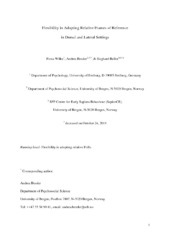| dc.contributor.author | Wilke, Fiona | |
| dc.contributor.author | Bender, Andrea | |
| dc.contributor.author | Beller, Sieghard | |
| dc.date.accessioned | 2020-06-17T09:03:23Z | |
| dc.date.available | 2020-06-17T09:03:23Z | |
| dc.date.issued | 2019 | |
| dc.Published | Wilke F, Bender A, Beller S. Flexibility in adopting relative frames of reference in dorsal and lateral settings.. The Quarterly journal of experimental psychology. Section A, Human experimental psychology. 2019;72(10):2393–2407 | eng |
| dc.identifier.issn | 1464-0740 | |
| dc.identifier.issn | 0272-4987 | |
| dc.identifier.uri | https://hdl.handle.net/1956/22671 | |
| dc.description.abstract | The relative frame of reference (FoR) is used to describe spatial relations between two objects from an observer’s perspective. Standard, frontal referencing situations with objects located in the observer’s visual field afford three well-established variants: translation, reflection, and rotation. Here, we focus on references in non-standard situations with objects located at the back or at the side of an observer (dorsal and lateral, respectively). We scrutinise the consistency assumption, which was introduced to infer the covert strategy used in dorsal tasks from an ambiguous overt response: that, when confronted with a non-standard situation, people adopt a strategy consistent with how they construct the relative FoR in frontal situations. Lateral tasks enable us to disentangle the ambiguous response. The results of a study in Norway and Germany support the consistency assumption in part: Nearly all participants with a preference for translation in frontal tasks applied translation in lateral tasks, and some participants with a preference for reflection in frontal tasks turned towards the objects before applying reflection in lateral tasks. Most other participants with a preference for reflection in frontal tasks, however, switched to translation in lateral tasks. The latter may be due to a specific affordance of the lateral arrangements, which invite translation as the easier strategy compared to the alternative derived from reflection. Our findings indicate that people do not apply their preferred variant of the relative FoR to all kinds of situations, but rather flexibly adapt their strategy when it is more convenient to do so. | en_US |
| dc.language.iso | eng | eng |
| dc.publisher | SAGE | eng |
| dc.title | Flexibility in adopting relative frames of reference in dorsal and lateral settings. | eng |
| dc.type | Peer reviewed | |
| dc.type | Journal article | |
| dc.date.updated | 2019-11-13T13:52:05Z | |
| dc.description.version | acceptedVersion | |
| dc.rights.holder | Copyright Experimental Psychology Society 2019 | eng |
| dc.identifier.doi | https://doi.org/10.1177/1747021819841310 | |
| dc.identifier.cristin | 1706141 | |
| dc.source.journal | The Quarterly journal of experimental psychology. Section A, Human experimental psychology | |
| dc.relation.project | Norges forskningsråd: 262618 | |
